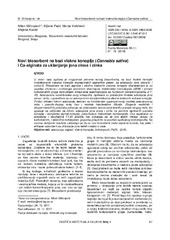Приказ основних података о документу
Hemp fibers (Cannabis sativa) impregnated by Ca-alginate gel as a novel biosorbent for the removal of Pb(II) and Zn(II) ions
Novi biosorbent na bazi vlakna konoplje (Cannabis sativa) i Ca-alginata za uklanjanje jona olova i cinka
| dc.creator | Milivojević, Milan | |
| dc.creator | Pejić, Biljana | |
| dc.creator | Vukčević, Marija | |
| dc.creator | Kostić, Mirjana | |
| dc.date.accessioned | 2021-03-10T13:40:07Z | |
| dc.date.available | 2021-03-10T13:40:07Z | |
| dc.date.issued | 2018 | |
| dc.identifier.issn | 0351-9465 | |
| dc.identifier.uri | http://TechnoRep.tmf.bg.ac.rs/handle/123456789/3833 | |
| dc.description.abstract | In this paper the possibility of implementing the new biosorbent composed of chemically modified short hemp fibers impregnated with alginate gel for adsorption of lead(II) and zinc (II) ions was investigated. Waste hemp fibers, alkaly treated, were used as an alginate carrier in order to improve the mechanical stability of alginate. Morphological characteristics of obtained alginate-hemp composite were investigated by scanning electron microscopy (SEM), while the Fourier transform infrared spectroscopy (FT-IR) was used for examination of surface chemistry. Alginate immobilization on the hemp fibers surface leads to the morphological changes, by decreasing the roughness of short hemp fibers. FT-IR analysis showed that surface chemistry was changed after alginate immobilization, primarily by increasing the amount of carboxyl groups. The presence of surface groups characteristic for hemp fibers, on the surface of biocomposite, indicate that the surface of hemp fibers is not completely covered by alginate. Adsorption characteristics of alginate-hemp biosorbent were examined through the adsorption of lead and zinc ions, and compared with the adsorption characteristics of alkali treated hemp fibers. Biosorption of lead and zinc ions onto both hemp fibers and alginate-hemp composite, represent fast process since 80 % of initial ions amount were adsorbed in first five minutes. Obtained adsorption data were analyzed by Lagergren pseudo-first and pseudo-second order kinetic models, as well as intraparticle diffusion model. It was found that biosorption of lead and zinc ions on alkali treated hemp fibers and alginate-hemp composite obey the pseudo-second order adsorption kinetics, indicating that adsorption/binding of ions is mediated by chemical forces rather than physical forces of attraction. This observation was confirmed by results of FT-IR analysis of alginate composite surface before and after ions adsorption. It was found that lead and zinc ions predominantly bind on carboxyl and hydroxyl groups through the ion-exchange and surface complexation. New biosorbent demonstrated effective removal of the ions, with the possibility of further process optimization in order to increase the adsorption capacity and rate of metal ions removal. | en |
| dc.description.abstract | U ovom radu ispitana je mogućnost primene novog biosorbenta, na bazi kratkih hemijski modifikovanih vlakana konoplje impregniranih alginatnim gelom, za adsorpciju jona olova(II) i cinka(II). Biosorbent na bazi alginata i alkalno tretiranih vlakana konoplje okarakterisan je sa aspekta strukture i morfologije primenom skenirajuće elektronske mikroskopije (SEM) i prirode funkcionalnih grupa korišćenjem infracrvene spektroskopije sa Furijeovim transformacijama (FT-IR). Adsorpcione karakteristike ovog kompozita, ispitivane su praćenjem kinetike adsorpcije jona olova i cinka, i upoređene su sa adsorpcionim karakteristikama alkalno tretiranih vlakana konoplje. Podaci dobijeni tokom adsorpcije, testirani su korišćenjem Lagergrenovog modela pseudo-prvog reda i pseudo-drugog reda, kao i modela intračestične difuzije. Slaganje modelnih i eksperimentalnih podataka pokazuje da adsorpcioni proces prati kinetiku pseudo-drugog reda, što upućuje na zaključak da tokom adsorpcije jona olova i cinka na površini ispitivanih uzoraka konoplje i kompozita alginat-konoplja, preovladava mehanizam hemisorpcije. Ova zapažanja su potvrđena i rezultatima FT-IR analize, koji pokazuju da se joni teških metala vezuju na karboksilnim, i delimično hidroksilnim grupama prisutnim na površini ispitivanog biokompozita. Na osnovu dobijenih rezultata zaključuje se da se novi biosorbent može uspešno koristiti, kao jeftin i efikasan adsorbent za uklanjanje jona teških metala iz vode. | sr |
| dc.publisher | Engineering Society for Corrosion, Belgrade, Serbia | |
| dc.relation | 41001 | |
| dc.relation | info:eu-repo/grantAgreement/MESTD/Basic Research (BR or ON)/172029/RS// | |
| dc.rights | openAccess | |
| dc.rights.uri | https://creativecommons.org/licenses/by-nc-nd/4.0/ | |
| dc.source | Zaštita materijala | |
| dc.subject | biosorption | en |
| dc.subject | alginate | en |
| dc.subject | hemp fibers | en |
| dc.subject | biocomposite | en |
| dc.subject | Pb(II) | en |
| dc.subject | Zn(II) | en |
| dc.subject | adsorpcija | sr |
| dc.subject | alginat | sr |
| dc.subject | vlakna konoplje | sr |
| dc.subject | biokompozit | sr |
| dc.subject | Pb(II) | sr |
| dc.subject | Zn(II) | sr |
| dc.title | Hemp fibers (Cannabis sativa) impregnated by Ca-alginate gel as a novel biosorbent for the removal of Pb(II) and Zn(II) ions | en |
| dc.title | Novi biosorbent na bazi vlakna konoplje (Cannabis sativa) i Ca-alginata za uklanjanje jona olova i cinka | sr |
| dc.type | article | |
| dc.rights.license | BY-NC-ND | |
| dc.citation.epage | 76 | |
| dc.citation.issue | 1 | |
| dc.citation.other | 59(1): 67-76 | |
| dc.citation.rank | M24 | |
| dc.citation.spage | 67 | |
| dc.citation.volume | 59 | |
| dc.identifier.doi | 10.5937/ZasMat1801069M | |
| dc.identifier.fulltext | http://TechnoRep.tmf.bg.ac.rs/bitstream/id/9841/0351-94651801067M.pdf | |
| dc.type.version | publishedVersion |

